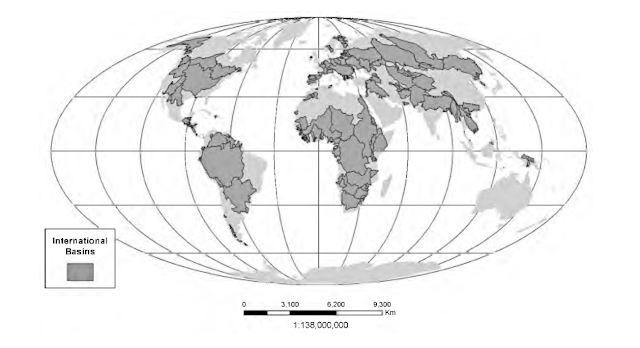The Zambezi River itself is 2,574 km long, runs through six countries in Southern Africa (Zambia, Angola, Namibia, Botswana, Zimbabwe, and Mozambique), and ends flowing into the Indian Ocean.
(Zvomuya 2017). It is one of the richest in Africa and heavily affects the hydroelectric, mining, agriculture, fishery, urban development, and tourism industries of the countries it runs through and the countries that lie within its basin.
(Soderbaum 2015). The Zambezi has been used for these purposes for years, however as issues of sustainability and increasing push for dams and hydroelectric power can cause issues for the traditional agricultural practices that rely on flooding which are used in a majority of Zambezi riparian countries. From the colonial era, two major dams, the Kariba in Zimbabwe and the Cahora Bassa in Mozambique began the transition of utilizing the river for more than traditional means. However this in combination with changing rainfall has created problems. The entire basin over the last decade has experienced inconsistent rainfall which has lead to new problems of water scarcity which has increased the need for international cooperation. Although the region has not seen militarized combat, growing conflict on how to manage water has been growing.
Water Scarcity:
Water scarcity, whether caused by environmental change or man-made issues, has become an increasing issue for the basin, Although the region has an abundance of water as a whole, certain regions experience drought at higher levels with the Intergovernmental Panel on Climate Change predicting worsening conditions in the years to come.
(Zvomuya 2017). In Table 1, you can see the stress indexes of the basin countries along with water withdrawal levels. Malawi and Zimbabwe are the key countries currently experiencing water stress, however, Tanzania and other countries could be at risk if management and conservation of water is not improved within the decade.
(Kirchhoff and Bulkley 2018). Sporadic rain, although not a new change, is causing water stress on many communities within the basin, the real issue lies in the lack of conservation efforts amongst the basin's countries.
Although the Southern African Development Community (SADC) has made efforts to help aid in water development initiative in the region, it's resources are limited and stretched thin around the regions it serves.
(Ibid.). However it has been successful in helping large scale projects and goals like the UN's Integrated Water Resource Management (IWRM) which has made efforts to aid in helping the basin countries conserve and manage water according to their three principles: ecological sustainability, social equity and economic efficiency. (Soderbaum 2015). As far as governance, there is also the Zambezi River Authority (ZRA), however this only has representatives from Zambia and Zimbabwe. Despite the lack of membership from other countries, the ZRA was able to get all eight countries to agree to Zambezi River Action Plan (ZACPLAN) though. This plan was meant to encourage and push the countries towards sustainable development and environmentally sound water practices, but issues of implementation and accountability has led to little to no progress from this initiative.
(Ibid.).
One of the biggest issues with transboundary cooperation actually lies within game theory. The Tragedy of the Commons is certainly at play in the implementation and failure of ZACPLAN. Many of the countries within the basin are not in a place economically to be able to implement sustainability protocols when the alternative (inefficient water use and management) is a more economically viable option.
(Jensen and Lange 2013). Table 2 shoes the economic standings of the basin countries, and although Namibia and Botswana are economically pretty stable, they are the countries with some of the least usage of the river. Therefore, according to theory, the resource will be drained because inefficient use that destroys the resource long term is better than not using it at all or investing in better development.
Hydropower Dams
One of the largest developments to the region has been the increase in plans to develop more hydropower dams. Before the turn of the century, the only two large hydropower schemes were the Kariba and Cahora Bassa, however with the increase in foreign development, many more are in the making. Hydropower and dams are a great investment to the basin countries as most are in need of power.
(World Bank 2010). The power gained from hydropower is used to fund other industries that are dependent on the river such as fishing, agriculture, mining, and tourism. Although these industries are also powered by coal and oil, hydropower is the only renewable and easily sustainable option that can be sold such as the energy generated by the Cahora Bassa Dam in Mozambique to South Africa.
(Jensen and Lange 2013). In Table 3, all of the ongoing or planned hydropower projects by foreign investors can be seen. These projects are mutually beneficial as much of Southern Africa is rich with resources and precious minerals but many countries lack infrastructure or power to mine them. China in the last decade has been one of the biggest investors in Africa, but that is a topic for another blog post.
These gains do not come without consequence though. The increas
e of dams thusly decreases downstream water flow. The biggest area that would experience the worst of these would be the Zambezi Delta. The area is one of the most productive regions of the country and boasts 230 kilometers of coastline fronting 18,000 square kilometers of floodplains and swamps that supports many industries.
(Zvomuya 2017). Any change in waterflow could severely damage the population's livelihood and negatively impact Mozambique's economy. Although a new dam between Zambia and Zimbabwe may help them economically, it becomes an issue because of the adverse effects to others. Changes to the river are not isolated acts, it affects everyone who is downstream. The delta will not be the only area affected by these changes, and increased cooperation will be needed to ensure that all the basin countries will not be negatively impacted.







Comments
Post a Comment